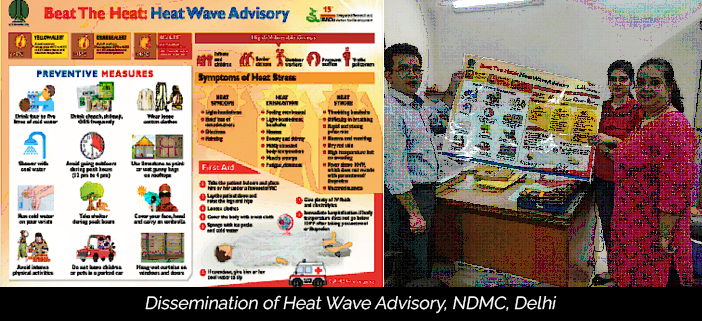Duration: November 2017 – November 2020 (Ongoing)
Supported by: International Development Research Centre (IDRC), Govt. of Canada
IRADe is working to assess impact of heat stress on livelihoods, productivity and health of vulnerable population in three Indian cities viz. Delhi, Rajkot and Bhubaneswar. The project aims to develop and support implementation of Heat Stress Action Plans for the selected cities. IRADe is working in collaboration with the Indian Institute of Public Health (Gandhinagar and Bhubaneswar), Odisha State Disaster Management Authority (OSDMA) and the municipal corporations of the respective cities. The work done up until now has been recognized by city, state, and national government, including the National Disaster Management Agency. These HSAPs will help prevent heat-related mortality, enable governments to protect poor and vulnerable citizens, improve the preparedness of hospitals/health centres, mitigate economic losses, and make Indian cities climate resilient.

| Surveys conducted | Numbers |
|---|---|
| Primary and Fortnight Surveys in 3 Cities |
|
| High Exposure Vulnerable (Occupational & Gender Specific) |
|

The study outputs and findings were presented to the City administrators, policy makers and related stakeholders in Bhubaneswar, Ahmedabad and Delhi.
City level awareness for prevention of heat related illnesses several initiatives have been taken; like preparation and distribution of heat stress prevention and management pamphlets across more than 10, 000 households in Rajkot, sharing the heat stress advisory with URJA (United Residents Joint Action) of Delhi for heat stress management in RWAs (Resident Welfare Associations) and awareness campaigns in over 100 plus Delhi schools. In addition, key short term actions have been recommended to the municipal corporations of the three cities to be implemented on an immediate basis for management for heat related illnesses. Strategies for management of heat stress and capacity building plan was developed for Rajkot city.
The study was done to assess the climatological variations in summer months (March, April, May and June), for a period ranging from 2001-2018, in three project cities. Daily data of climate parameters: Maximum Temperature (Tmax), Minimum Temperature (Tmin), Relative Humidity measured at 8:30 AM [RH (830)], and Relative Humidity measured at 5:30 PM [RH (1730)], was collected from Indian Meteorology Department (IMD). The climatology data was analysed further by comparing with the city’s long-term climatological mean Tmax and Tmin
(mean of 1905 to 2000) for the corresponding months, to determine the deviation in the city’s temperature and humidity.
It was observed that March is getting hotter in Delhi at a relatively faster rate as compared to the rest of summer months, with an average rise in T max by + 1.2 degrees C in the period of 2010-18. Bhubaneswar also showed a similar trend with the average rise in T Max by +1.4 degree C in March for the period 2008-18. In Rajkot, there was an average rise of temperature by + 1.2 degree C in April during 2001-17. RH [8:30] for Bhubaneswar has also shown an increase of 2.65% during the period 2008-18. For Rajkot, RH [8:30] showed a maximum increase of 1.12 % in April during 2004-17. RH, measured at 17:30 hrs, showed a maximum spike of 2.94% for June during 2008-18 in Bhubaneswar. For Rajkot, RH [1730] showed a maximum increase of 2.46% for June during 2004-17. No significant trend in RH was observed in the project cities.
Ward level Heat stress vulnerability in Delhi, Rajkot and Bhubaneswar was analysed using a comprehensive index comprising nine sectors – Sanitation, Water, Electricity, Health, Transportation, Housing, Cooking, Awareness and Heat symptoms, and their respective sub-sectors. The cumulative ward wise heat stress vulnerability was categorised into low, medium and high. The ward level vulnerability map for Rajkot and Bhubaneswar city is highlighted in the following map. Assessment of ward level vulnerability will help cities to prioritise focussed actions on the vulnerable areas and vulnerable groups

Consultations with stakeholders at the city level (Bhubaneswar, Rajkot and Delhi) were done to sensitize them about the need for Heat Stress Action Plans. Also, the stakeholders – City Health Departments, Rajkot Municipal Corporations, Bhubaneswar Municipal Corporation, New Delhi Municipal Corporation, Smart City departments, Town planning departments, were approached for relevant data, discussion of project activities and work plan. A meeting with the Honourable Minister of Environment and Forests, Govt. of Delhi, Mr Imran Hussain, was held to discuss the design and implementation of Heat Stress Action Plan for Delhi.
A Heat Stress Advisory was prepared in collaboration with the medical services department of New Delhi Municipal Corporation and it was distributed among the Medical Services Department of NDMC. The preventive measures that can be taken to avoid heat-related illnesses were also incorporated on the prescription slips of NDMC Charak Palika hospital and associated dispensaries.
In Rajkot, IRADe in collaboration with the Rajkot Municipal Corporation (RMC), actively implemented the Heat Stress Action Plan (HSAP) in the city. Some of the key public awareness initiatives like Hoardings at public places, LED Screen to display Heat Advisory, distribution of more than 15,000 posters and pamphlets in regional language and initiating Early warning systems using 20 temperature sensors across the city.


A Medical Stakeholders Training Module has also been developed to aid in the training. The Heat Stress Action Plan for Rajkot was accepted by the Rajkot Municipal Corporation. In Bhubaneswar, a Draft Heat Stress Action Plan has been prepared and discussed with city level stakeholders. The Odisha State Disaster Management Authority has already incorporated research and action inputs from IRADe into the Odisha Heat Action Plan for 2020
